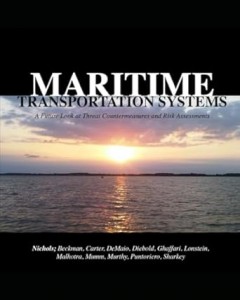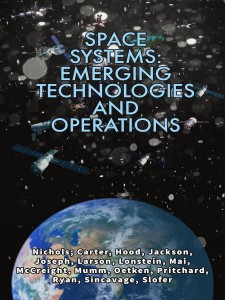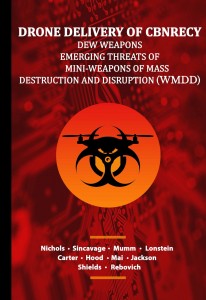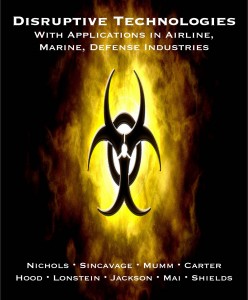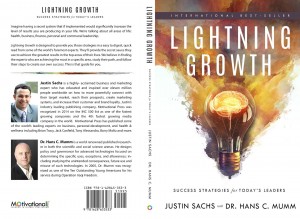Maritime Transportation Systems (Nichols et al., 2025) is the eleventh textbook in a distinguished series exploring Unmanned Aircraft Systems (UAS), Counter-UAS (CUAS), Unmanned Underwater Vehicles (UUVs), space, and maritime operations. Previous titles, including Survival in Space (Nichols & Alex, 2025), Advanced Technologies for Humanity (Nichols et al., 2024), Space Systems: Emerging Technologies and Operations (Nichols & Carter, 2022), Drone Delivery of CBNRECy – DEW Weapons (Nichols et al., 2021), Disruptive Technologies with Applications in Airline, Marine, Defense Industries (Nichols et al., 2020), Unmanned Vehicle Systems & Operations on Air, Sea, Land (Nichols et al., 2020), Counter Unmanned Aircraft Systems Technologies and Operations (Nichols et al., 2019), and both editions of Unmanned Aircraft Systems in the Cyber Domain (Nichols et al., 2018, 2022), have earned global recognition for their contributions to these fields.
The Maritime Transportation System (MTS) exhibits significant security vulnerabilities, often likened to a “Swiss cheese” model due to its multiple exploitable weaknesses. Through rigorous risk assessments, the Wildcat author team identified vulnerabilities with the greatest potential for threat exploitation, revenue loss, intelligence compromise to Foreign Intelligence Organizations (FIOs), or military harm. Key concerns include threats to submarine communication cables and landing points, U.S. Navy vulnerabilities in the South China Sea—particularly around Guam and Hawaii—cyberattacks on MTS Supervisory Control and Data Acquisition (SCADA) subsystems, port security, shipboard networks and communication systems, risks to advanced U.S. Navy weaponry, piracy and anti-piracy measures, UAS and UUV threats launched from maritime platforms, and offshore chemical engineering applications. The book concludes with strategic maritime defense recommendations, aiming to guide MTS managers and policymakers in securing their operational domains.
Avaliable on Amazon:
SURVIVAL IN SPACE is our tenth textbook in a series covering the world of UASs / CUAS / UUVs / SPACE. Everything in Space is trying to kill us! We look at some of these killers and some of the technologies to protect our explorers. We address the technological future of astronauts’ survival in Space. We explore innovations to space operations and defense against threats that are concomitant with their development. State-of-the-art research by a team of twenty-one SMEs is incorporated into our book! We trust you will enjoy reading our research as much as we have in its writing. There is hope for the future. There are also caution and quality risk assessments required.
Here’s our book’s breakdown:
Dr. Ronke Olabisi, in her terrific course and book How to Survive in Space, named twelve astronaut killers: space launch, short-and long-term weightlessness, microbes in Space, space suit, vacuum, extreme temperatures, space food, extreme confinement, space radiation, medical emergencies and touchdown. (Olabisi, 2024) We brought in our experts, chose key killers, and devoted our chapters, namely to microbes, growth, and consuming/logistics of food in Space, radiation, and medical trauma in Space.
Next, we moved into the bigger picture with chapters that considered communications in deep Space, AI /VR space applications, robotics applications, and applicable laws in Space.
But our target is higher and farther away, namely MARS. We are going there someday, so we looked at the MARS Habitat, the associated Terrestrial Logistics, and the required advanced manufacturing and materials in Space.
Survival in Space means protecting Space and Boundaries of Sovereignty. This is a military function, so we devote a final chapter to the military perspective and composition of forces in space battles.
SURVIVAL IN SPACE is our tenth textbook in a series covering the world of UASs / CUAS/ UUVs / Space. Other textbooks in our series are Advanced Technologies for Humanity; Space Systems Emerging Technologies and Operations; Drone Delivery of CBNRECy – DEW Weapons: Emerging Threats of Mini-Weapons of Mass Destruction and Disruption (WMDD); Disruptive Technologies with applications in Airline, Marine, Defense Industries; Unmanned Vehicle Systems & Operations On Air, Sea, Land; Counter Unmanned Aircraft Systems Technologies and Operations; Unmanned Aircraft Systems in the Cyber Domain: Protecting USA’s Advanced Air Assets, 2nd edition; and Unmanned Aircraft Systems (UAS) in the Cyber Domain Protecting USA’s Advanced Air Assets, 1st edition. Our previous nine titles have received considerable global recognition in the field. (Nichols & et.al., Advanced Technologies for Humanity, 2024) (Nichols & Carter, 2022) (Nichols et al., 2021)(Nichols R. K. et al., 2020) (Nichols R. et al., 2020) (Nichols R. et al., 2019) (Nichols R. K., 2018) (Nichols R. K. et al., 2022)
Avaliable on Amazon:
ADVANCED TECHNOLOGIES FOR HUMANITY is our ninth textbook in a series covering the world of UASs / CUAS / UUVs / Space. In this book, we change our perspective from advanced weapons and intelligence (potentially harmful to humanity) to exploring the use of advanced technologies to benefit society. The authors chose vital technologies that we envision can be used to help humanity survive or turn into less threatening outcomes for society. Chapter One introduces Wargaming and Artificial intelligence. In it, we understand how OODA decision loops can be used for plans and societal decisions. Chapter two addresses Mobility. It is a deep look into the devices that control our daily lives. It presents a holistic view of connectivity and the changes that need to be made. Chapter three discusses the Metaverse and the risks that society is taking. Chapter four brings us back to basics. It teaches how to write in plain language and research important information. It brings a slew of support links to the table. Chapter five shows us the plan and promise of IoT. Everything is connected. Chapter six focuses on advanced robotics and how it is transforming humanity. What autonomous systems will we have to contend with in the future? Chapter seven is a powerful look into the intersection of biotechnology and AI. It is a combination of warning and future possibilities. Chapter eight is crucial to leveraging advanced technologies to enhance food production. Chapter nine presents a systems-dynamic view of humanitarian efforts. It introduces a balanced humanitarian technology security system. Chapter ten is a complex review of quantum computing limits, enhancements, applications, and core principles. It is not for the faint of heart. Chapter eleven asks the question: has social media worn out its welcome? It reveals the laws that protect us and censor us. It is a needed reality check. The ending chapter entitled Feed The Planet is a story to be heard. It envisions organizing hanging gardens in Africa that can produce food for millions of families. It is a beautiful vision that sums up our goals.
Avaliable on Amazon:
CYBER-HUMAN SYSTEMS, SPACE TECHNOLOGIES, AND THREATS is our eighth textbook in a series covering the world of UASs / CUAS / UUVs / SPACE. We address the technological future of the merging of cyber-human systems (robots, cyborgs, AI/ML, computers) with humans and apply these innovations to space operations and defense against threats that are concomitant with their development. We look at artificial brains, legality of CHS sensors, AI /ML and Ag and food industry; Neurostrike and CHATGPT, biological threats and growth in space, space EW, modeling, deep space warfare, logistics and dominance; hypersonic missiles, cyber threats in space, machine parts, materials technologies, and economies of scale, quantum technologies impact and finally, innovative wireless power transfer for space applications. State-of-the-Art research by a team of eighteen SMEs is incorporated into our book. We trust you will enjoy reading it as much as we have in its writing. There is hope for the future. There is also caution needed.
————————————————————————————————————————————————————————————————————————————————————————————————————
https://www.amazon.com/gp/product/B0BHNLQSNQ/ref=dbs_a_def_rwt_hsch_vamf_tkin_p1_i4
https://newprairiepress.org/ebooks/47/
https://kstatelibraries.pressbooks.pub/spacesystems/
SPACE SYSTEMS: EMERGING TECHNOLOGIES
AND OPERATIONS is our seventh textbook in a series covering the world of UASs / CUAS/ UUVs. Other textbooks in our series are Drone Delivery of CBNRECy – DEW Weapons: Emerging Threats of Mini-Weapons of Mass Destruction and Disruption (WMDD); Disruptive Technologies with applications in Airline, Marine, Defense Industries; Unmanned Vehicle Systems & Operations On Air, Sea, Land; Counter Unmanned Aircraft Systems Technologies and Operations; Unmanned Aircraft Systems in the Cyber Domain: Protecting USA’s Advanced Air Assets, 2nd edition; and Unmanned Aircraft Systems (UAS) in the Cyber Domain Protecting USA’s Advanced Air Assets, 1st edition. Our previous six titles have received considerable global recognition in the field. (Nichols & Carter, 2022) (Nichols, et al., 2021) (Nichols R. K., et al., 2020) (Nichols R., et al., 2020) (Nichols R. , et al., 2019) (Nichols R. K., 2018) [1]
Our seventh title takes on a new purview of Space. Let’s think of space as divided into four regions. Planets, solar systems, and the great dark void fall into the purview of astronomers and astrophysics. The earth, from a measurement standpoint, is the baseline of space. It is the purview of geographers, engineers, scientists, politicians, and romantics. Flying high above the earth are Satellites. Their purview is governed by military and commercial organizations. The lowest altitude at which air resistance is low enough to permit a single complete, unpowered orbit is approximately 80 miles (125 km) above the earth’s surface. Normal LEO satellite launches range between 99 miles (160 km) to 155 miles (250 km). Satellites in higher orbits experience less drag and can remain in space longer in service. Geosynchronous orbit is around 22,000 miles (35,000 km). However, orbits can be even higher. The Russians claim they placed a radio astronomy satellite in a long elliptical orbit that carries it nearly as far as the moon. (Hardwick, 2022) UASs (Drones) have a maximum altitude of about 33,000 ft (10 km) because rotating rotors become physically limiting. (Nichols R. , et al., 2019) Recreational drones fly at or below 400 ft in controlled airspace (Class B, C, D, E) and are permitted with prior authorization by using a LAANC or DroneZone. Recreational drones are permitted to fly at or below 400 ft in Class G (uncontrolled) airspace. (FAA, 2022) However, between 400 ft and 33,000 ft is in the purview of DREAMERS.
In the DREAMERS region, space has its most interesting technological emergence. We see emerging technologies and operations that may have profound effects on humanity. This is the mission our book addresses. We look at the Dreamer region from three perspectives: a military view where intelligence, jamming, spoofing, advanced materials, and hypersonics are in play. An exploration of the challenges in the Dreamer region follows. These include space-based platform vulnerabilities, trash, disaster recovery management, AI, manufacturing, and extended reality. Lastly, we dramatically shift to the humanitarian use of space technologies. This includes precision agriculture wildlife tracking, fire risk zone identification, and improving the global food supply and cattle management.
State-of-the-Art research by a team of fifteen SMEs is incorporated into our book. We trust you will enjoy reading it as much as we have in its writing. There is hope for the future.
————————————————————————————————————————————————————————————————————————————————————————————————————-
Amazon Author Page: https://www.amazon.com/
Available as free eBook at: https://newprairiepress.org/ebooks/46/
Drone Delivery of CBNRECy – DEW Weapons: Emerging Threats of Mini-Weapons of Mass Destruction and Disruption (WMDD) is our sixth textbook in a series covering the world of UASs & UUVs. Other textbooks in our series are Disruptive Technologies with applications in Airline, Marine, Defense Industries; Unmanned Vehicle Systems & Operations On Air, Sea, Land; Counter Unmanned Aircraft Systems Technologies and Operations; Unmanned Aircraft Systems in the Cyber Domain: Protecting USA’s Advanced Air Assets, 2nd edition; and Unmanned Aircraft Systems (UAS) in the Cyber Domain Protecting USA’s Advanced Air Assets, 1st edition. Our previous five titles have received considerable global recognition in the field. (Nichols et al., 2021) (Nichols R. K. et al., 2020) (Nichols R. et al., 2020) (Nichols R. et al., 2019) (Nichols R. K., 2018) [1]
Our sixth title is a new purview for UAS / CUAS / UUV (drones). We are concerned with the future use of these inexpensive devices and their availability to maleficent actors. As I write this Preface, we are on the 56th day of the savage invasion of Ukraine by Russia under President Putin. The Russian drone fleet numbers are above 500. They have had five years to grow their fleet. It currently uses them for domestic security, Syrian operations, and defense. (Facon, 2016) In the conflict, Russian troops seriously outnumber Ukrainian forces. However, on February 8, 2022, a Forbes report stated that Ukraine used 20 Turkish TB-2 drones to hit Russian targets and offset some of Russia’s enormous military advantages. (Malsin, 2022) According to Fox News, on February 27, 2022, President Putin ordered nuclear deterrent forces status raised to “special combat readiness” (Colton, 2022)
News like this in just one conflict suggests that UASs in air and underwater will be the future of military operations. They can deliver a huge punch for a low investment and minimize human casualties. Our team believes that China is watching both the United States’ Neville Chamberlain appeasement strategy and the aggressive nature of Russia in its full-scale invasion of its neighbor. This portends that Taiwan is the next meal on the global plate. Unfortunately, two other state actors have season tickets: Iran and North Korea. Iran’s drone fleet is impressive and has caused other Gulf states’ inventories to escalate (UAE, Kingdom of Saudi Arabia, Egypt, Iraq, Jordan, Israel) (Barrie, 2021). North Korea (NK) lies about its air power. However, one report states that NK will have drones with stealth capability. (Choi, 2021) Maybe. According to Datablog, the US has the most drones and is best equipped for warfare. China, of course, might dispute these statistics. (DATABLOG, 2012)[2][3]However, carrying a big stick doesn’t count anymore in the UAS’s future military play without the will to use it.
Our Wildcat team is composed of some impressive SMEs. We divided the work into four sections. Section 1 covers Chemical, Biological, Radiation, Nuclear, Explosive (CBRNE) weapons and payloads delivered by unmanned vehicles. Here we look at the technologies and damage delivered by drones as mini weapons of mass destruction and disruption. Chapter 7 concentrates on Deception and how drones can be used in PSYOPS and INFOWAR. Section 2 concentrates on Directed Energy Weapons (DEW), projectiles payloads, satellite killers, port disrupters, and cyberweapons against CBRN assets. Section 3 looks at policy considerations, risk assessments of threats and vulnerabilities of drone-based WMDD / DEW, practical crime scene investigations for hot zones, and unique challenges of responding to bioterrorism and chemical threats and attacks delivered by drones. Our final Section 4 concludes with social networking implications and DRONESEC security and tracking tools of the trade.
Over two years of solid research by a team of eleven SMEs is incorporated into our book. We trust you will enjoy reading it as much as we have in its writing. There are nightmares aplenty.
Available as free eBook at: https://newprairiepress.org/ebooks/46/
—————————————————————————————————————————————
 https://www.amazon.com/author/hansmumm-drones-autonomous
https://www.amazon.com/author/hansmumm-drones-autonomous
Disruptive Technologies With Applications in Airline, Marine, Defense Industries is our fifth textbook in a series covering the world of Unmanned Vehicle Systems & Operations On Air, Sea, Land; Counter Unmanned Aircraft Systems Technologies and Operations; Unmanned Aircraft Systems in the Cyber Domain: Protecting USA’s Advanced Air Assets, 2nd edition; and Unmanned Aircraft Systems (UAS) in the Cyber Domain Protecting USA’s Advanced Air Assets, 1st edition; have seen considerable global recognition in the field. (Nichols R. K., et al., 2020) (Nichols R., et al., 2020) (Nichols R., et al., 2019) (Nichols R. K., 2018).
The authors have expanded their purview beyond UAS / CUAS / UUV systems we have written extensively about in our previous four books. Our new title shows our concern for the emergence of Disruptive Technologies and how they apply to the Airline, Marine, and Defense industries.
There is a difference between emerging technology trends and disruptive ones. Emerging technologies are technologies whose development, practical applications, or both are still largely unrealized, such that they are figuratively emerging into prominence from a background of nonexistence or obscurity. (Wiki, 2021) Some sources say that emerging technologies are taking over the world by a storm, and if misused, it could turn out to be our worst enemy. (Rose, 2019) Toward Data Science magazine lists Drone Swarms as number one in their list. The topic covered in detail in (Nichols R., et al., 2020). Smart home devices that spy, ex. IoT or AI / IoT is number two, followed by facial recognition, spy dust, and autonomous robots. (Rose, 2019)
A Disruptive technology is one that displaces an established technology and shakes up the industry or a ground-breaking product that creates a completely new industry. (Rouse, 2021)
That is what our book is about. We think we have found technology trends that will replace the status quo or disrupt the conventional technology paradigms.
We have written some explosive chapters in Book 5. Dr. Hans Mumm has written about the advances in Automation & Human Machine Interface. Wayne Lonstein, JD has given the reader a solid look at Social Media as a Battleground in Information Warfare (IW). CEO Bart Shields has delivered a viable, less risky, more robust cyber-security alternative/replacement for the popular Blockchain Algorithm and a clean solution for Ransomware. Professor Randall Nichols has written about the advanced sensor technologies that are used by UUVs for munitions characterization, assessment, and classification. He reports on their counter hostile use of UUVs against US capital assets in the South China Seas. In a second chapter, Professor Nichols has challenged the status quo and debunked the climate change fraud with verifiable facts. In his third chapter, he explodes our minds with nightmare technologies that, if they come to fruition, may do more harm than good. Some of them might reach Black Swan event status.
Dr. Mark Jackson has written authoritatively about Propulsion and Fuels: Disruptive Technologies for Submersible Craft Including UUVs. CEO Randall Mai has penned a chapter to challenge the ammunition industry by grassroots use of recycled metals and an alternative propellant – air. Captain John – Paul Hood writes about the changing landscape of UAS regulations and privacy. 2021 will prove to be challenging for owners and manufacturers of UAS. CEO & Dr. Suzanne Sincavage and Professor Candice Carter have teamed up to scare the pants off of us – especially during the COVID-19 pandemic – by detailing Bioterrorism Risks, Biodefense, Biological Threat Agents, and the need for advanced sensors to detect these attacks.
Over two years of solid research by a team of nine SMEs is incorporated into our book. We trust you will enjoy reading it as much as we have in its writing.
______________________________________________________________________________________________________________________________________________________________________________________________

UNMANNED VEHICLE SYSTEMS & OPERATIONS ON AIR, SEA, LAND
By Nichols, R. K., Ryan, J., J.C.H., Mumm, H.C., Lonstein, W.D., Carter, C., Hood, J.P, Mai, R., Shay, J., & Jackson, M.
https://www.amazon.com/dp/
This is our fourth textbook in a series previously covering the world of Unmanned Aircraft Systems (UAS) and Counter Unmanned Aircraft Systems (CUAS). Unmanned Aircraft Systems in the Cyber Domain: Protecting USA’s Advanced Air Assets, 2nd edition and Counter Unmanned Aircraft Systems Technologies and Operations have seen considerable global recognition in the field. (Nichols R. , et al., 2019) (Nichols R. , et al., 2020)
The authors have expanded our purview beyond UAS / CUAS systems. Our title shows our concern for growth and unique operations for all unmanned vehicles in all theaters: Air, Sea and Land. Three different factors have spurred the authors into expanding our textbook offerings. First, unmanned technology has seen an economic explosion in production, sales, testing, specialized designs, and friendly / hostile usages of deployed UAS / UAVs / Drones / UUVs / UDV / UGTs (hereafter referred to as a group as UVs). There is a huge global growing market and entrepreneurs know it. Small UV companies have been reproducing like rabbits. Many companies are exploring / creating new, unique, and profitable unmanned technologies for all military branches, LEO, commercial, high-mountain and deep-sea rescue, and recreational purposes. Covid-19 has brought a new dimension to UV planning and designs for medical and rescue missions.
Second, hostile use of UVs is on the forefront of DoD defense and offensive planners. They are especially concerned with SWARM behaviors in the air, over land and a new threat of underwater. The influence of IoT, AI and Cyber technologies has complicated the defense planning mission
Third, UV technology has outpacing our first and second editions plus our textbook on CUAS. Everyday our writers group read / discussed new UAS / UV developments in navigation, weapons, surveillance, data transfer, fuel cells, stealth, weight distribution, tactics, GPS / GNSS ( and replacement technologies) elements, SCADA protections, privacy invasions, legislation, big-data usage, terrorist uses, cryptographic protections, pressure protection for deep water exploration, maintenance, rescue or intelligence gathering; ASW, and defense; specialized software and security protocols and more. As authors we felt compelled to address at least the edge of some of these new UV developments. It was clear that we would be lucky if we could cover some of the more interesting and priority technology updates for the various UV AOs.
Expanded purview means more experience was needed to write our newest work. We are privileged to add to original writing team of Nichols, Ryan, Mumm, Lonstein, Carter, and Hood new SMEs in the various UV technologies: Mai, Jackson, and Shay. Their extensive backgrounds are found in our tribute to the authors in a latter section.
Here is an outline of topics in our latest work: SECTION 1: UNMANNED AIRCRAFT SYSTEMS
Chapter 1 Information Advances, Remote ID, & Extreme Persistence ISR [Ryan]
Chapter 2 : Unmanned Aerial Vehicles & How They Can Augment Mesonet Weather Tower Data Collection [Mai]
Chapter 3 Tour de Drones for the Discerning Palate [Nichols]
SECTION 2: UNMANNED UNDERWATER SYSTEMS
Chapter 4 Underwater Autonomous Navigation & other UUV Advances [Mumm]
Chapter 5 Autonomous Maritime Asymmetric Systems [Hood]
Chapter 6 UUV Integrated Autonomous Missions & Drone Management [Mumm]
Chapter 7 Principles of Naval Architecture Applied to UUV’s [Jackson]
SECTION 3: UNMANNED VEHICLES FOR GROUND / LAND OPERATIONS & Penetration of ADS
Chapter 8 : Unmanned Logistics Operating Safely & Efficiently Across Multiple Domains [Lonstein]
Chapter 9 Chinese Advances in Stealth UAV Penetration Path Planning in Combat Environment [Nichols]
SECTION 4: UNMANNED VEHICLES WEAPONS FOR C4ISR & POPULATION TRACKING & CONTROL
Chapter 10 UAS, the Fourth Amendment and Privacy [Shay]
Chapter 11 UV & Disinformation / Misinformation Channels [Ryan]
SECTION 5: UV GEOPOLITICAL & LEGAL ADVANCES
Chapter 12 Chinese UAS Proliferation along New Silk Road Sea / Land Routes [Carter]
Chapter 13 Automaton, AI, Law, Ethics, Crossing the Machine – Human Barrier [Lonstein]
Chapter 14 Maritime Cybersecurity [Nichols]
We trust our newest look at Unmanned Vehicles in Air , Sea and Land will enrich our students and readers understanding of the purview of this wonderful technology we call UV.
______________________________________________________________________________________________________________________________________
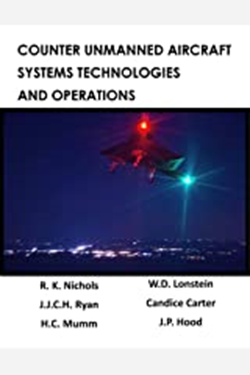
As the quarter-century mark in the 21st Century nears, new aviation-related equipment has come to the forefront, both to help us and to haunt us. (Coutu, 2020) This is particularly the case with unmanned aerial vehicles (UAVs). These vehicles have grown in popularity and accessible to everyone. Of different shapes and sizes, they are widely available for purchase at relatively low prices. They have moved from the backyard recreation status to important tools for the military, intelligence agencies, and corporate organizations. New practical applications such as military equipment and weaponry are announced on a regular basis – globally. (Coutu, 2020) Every country seems to be announcing steps forward in this bludgeoning field.
In our successful 2nd edition of Unmanned Aircraft Systems in the Cyber Domain: Protecting USA’s Advanced Air Assets (Nichols, et al., 2019), the authors addressed three factors influencing UAS phenomena. First, unmanned aircraft technology has seen an economic explosion in production, sales, testing, specialized designs, and friendly/hostile usages of deployed UAS / UAVs / Drones. There is a huge global growing market and entrepreneurs know it. Second, hostile use of UAS is on the forefront of DoD defense and offensive planners. They are especially concerned with SWARM behavior. Movies like “Angel has Fallen,” where drones in a SWARM use facial recognition technology to kill USSS agents protecting POTUS, have built the lore of UAS and brought the problem forefront to DHS. Third, UAS technology was exploding. UAS and Counter- UAS developments in navigation, weapons, surveillance, data transfer, fuel cells, stealth, weight distribution, tactics, GPS / GNSS elements, SCADA protections, privacy invasions, terrorist uses, specialized software, and security protocols have exploded. (Nichols, et al., 2019) Our team has followed/tracked joint ventures between military and corporate entities and specialized labs to build UAS countermeasures.
As authors, we felt compelled to address at least the edge of some of the new C-UAS developments. It was clear that we would be lucky if we could cover a few of – the more interesting and priority technology updates – all in the UNCLASSIFIED and OPEN sphere.
Counter Unmanned Aircraft Systems: Technologies and Operations is the companion textbook to our 2nd edition. The civilian market is interesting and entrepreneurial, but the military and intelligence markets are of concern because the US does NOT lead the pack in C-UAS technologies. China does. China continues to execute its UAS proliferation along the New Silk Road Sea / Land routes (NSRL). It has maintained a 7% growth in military spending each year to support its buildup. (Nichols, et al., 2019) [Chapter 21]. They continue to innovate and have recently improved a solution for UAS flight endurance issues with the development of advanced hydrogen fuel cell. (Nichols, et al., 2019) Reed and Trubetskoy presented a terrifying map of countries in the Middle East with armed drones and their manufacturing origin. Guess who? China. (A.B. Tabriski & Justin, 2018, December)
Our C-UAS textbook has as its primary mission to educate and train resources who will enter the UAS / C-UAS field and trust it will act as a call to arms for military and DHS planners.
ISBN: 978-1-944548-27-8
Publication Date: Winter 2-1-2020
Publisher: New Prairie Press
City: Manhattan
Editor: Professor Randall K. Nichols
Keywords:
Counter Unmanned Aircraft Systems, C-UAS, Cybersecurity, Online Cybersecurity Certificate, Cyber Security, Cybersecurity, Cyber Security Course, Online Cybersecurity courses, Cybersecurity program, Cybersecurity Books, Cybersecurity specialist, Security book, Cyber Domain, Cybersecurity professional, Information security books, Cybersecurity and cyberwar, Cyberwar book, Infosec books, DRONE, UAS, UAV/Drone, UCAV, Unmanned Aircraft Systems, Aircraft, Intelligence, Surveillance, Reconnaissance, C4ISR, ISR Platforms, Autonomous Drone, SWARM, Aviation unmanned, Air drone, Commercial drones, Drone applications, Defense, Air Assets, UAS capabilities, Drone aviation, Drone controllers, Hostile Use, Drone Technology, Flying drones for military, UAS/Drone warfare, Small surveillance drones, SUAS, UAV Drone, UAV payloads, Unmanned Aerial Systems, Unmanned Aerial Vehicle, Unmanned Aircraft Systems, Unmanned Aircraft
Disciplines
Aeronautical Vehicles | Aerospace Engineering | Aviation and Space Education | Higher Education | Other Aerospace Engineering
Recommended Citation
Nichols, Randall K.; Mumm, Hans C.; Lonstein, Wayne D.; Ryan, Julie J.C.H; Carter, Candice; and Hood, John-Paul, “Counter Unmanned Aircraft Systems Technologies and Operations” (2020). NPP eBooks. 31.
https://newprairiepress.org/
![Unmanned Aircraft Systems in the Cyber Domain: Protecting USA's Advanced Air Assets by [Nichols, Randall, Ryan, Julie, Mumm, Hans, Lonstein, Wayne, Carter, Candice, Hood, John]](https://images-na.ssl-images-amazon.com/images/I/41UPtTgvkiL.jpg)
What you will learn:
Unmanned Aircraft Systems are an integral part of the US national critical infrastructure. The authors have endeavored to bring a breadth and quality of information to the reader that is unparalleled in the unclassified sphere. This textbook will fully immerse and engage the reader/student in the cyber-security considerations of this rapidly emerging technology that we know as unmanned aircraft systems (UAS).
The first edition topics covered National Airspace (NAS) policy issues, information security (INFOSEC), UAS vulnerabilities in key systems (Sense and Avoid / SCADA), navigation and collision avoidance systems, stealth design, intelligence, surveillance and reconnaissance (ISR) platforms; weapons systems security; electronic warfare considerations; data-links, jamming operational vulnerabilities and still-emerging political scenarios that affect US military / commercial decisions.
This second edition discusses state-of-the-art technology issues facing US UAS designers. It focuses on counter unmanned aircraft systems (C-UAS) – especially research designed to mitigate and terminate threats by SWARMS. Topics include high-altitude platforms (HAPS) for wireless communications; C-UAS and large scale threats; acoustic countermeasures against SWARMS and building an Identify Friend or Foe (IFF) acoustic library; updates to the legal / regulatory landscape; UAS proliferation along the Chinese New Silk Road Sea / Land routes; and ethics in this new age of autonomous systems and artificial intelligence (AI).
What you will learn:
Unmanned Aircraft Systems (UAS) are an integral part of the US national critical infrastructure. They must be protected from hostile intent or use to the same level as any other military or commercial asset involved in US national security. However, from the Spratly Islands to Djibouti to heartland America, the expanding Chinese Unmanned Aircraft Systems (UAS / Drone) industry has outpaced the US technologically and numerically on all fronts: military, commercial, and recreational. Both countries found that there were large information security gaps in unmanned systems that could be exploited on the international cyber-security stage. Many of those gaps remain today and are direct threats to US advanced Air Assets if not mitigated upfront by UAS designers and manufacturers. The authors contend that US military / commercial developers of UAS hardware and software must perform cyber risk assessments and mitigations prior to delivery of UAS systems to stay internationally competitive and secure. The authors have endeavored to bring a breadth and quality of information to the reader that is unparalleled in the unclassified sphere. This book will fully immerse and engage the reader in the cyber-security considerations of this rapidly emerging technology that we know as unmanned aircraft systems (UAS). Topics covered include National Airspace (NAS) policy issues, information security, UAS vulnerabilities in key systems (Sense and Avoid / SCADA), collision avoidance systems, stealth design, intelligence, surveillance and reconnaissance (ISR) platforms; weapons systems security; electronic warfare considerations; data-links, jamming operational vulnerabilities and still-emerging political scenarios that affect US military / commercial decisions.
What you will learn:
Imagine having a secret system that if implemented would significantly increase the level of results you are producing in your life. We’re talking about all areas of life: health, business, finance, and personal and communal leadership.
Lightning Growth is designed to provide you those strategies in a easy to digest, quick audiobook from some of the world’s foremost experts. They’ll provide the secret sauce they use to achieve the greatest results in the top areas of their lives. We believe in finding the experts who are achieving the most in a specific area, studying their path, and following their steps to create our own success. This is that guide for you.
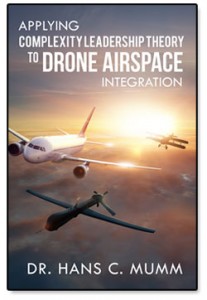
What you will learn:
- How complexity leadership can solve the policy disconnect between the FAA and the drone user community.
- Applying complexity leadership theory will expedite the Federal Aviation Rulemaking Committees decision making processes that are currently linear and authoritarian in nature which is preventing the development of any timely rules for integrating drones/UAVs into the National Air Space.
- How complexity leadership creates the vision to the simplest path possible for the drone/UAV community to integrate fully into the National Airspace System.
- Reviews latest research in the use and integration of complexity theory leadership as it applies to Drone Airspace Integration
- Illustrates the value of implementing, non-linear, non-authoritarian and self-organizing approaches to problem solving.
” In this era of covertly evolving threats to our national and homeland security, and the complicated leadership that is required to manage the safety and security of our society, Dr. Mumm’s intellectual and tactical prowess has given us that needed edge in this book. His work on applying the complexity leadership theory to managing drone airspace, in support of our local and global security affairs, is a paradigm for managing what can be considered an unmanageable political arena.”
-Michael L. Hummel, Ph.D. Professor and Chair, Department of Criminal Justice, California University of Pennsylvania
